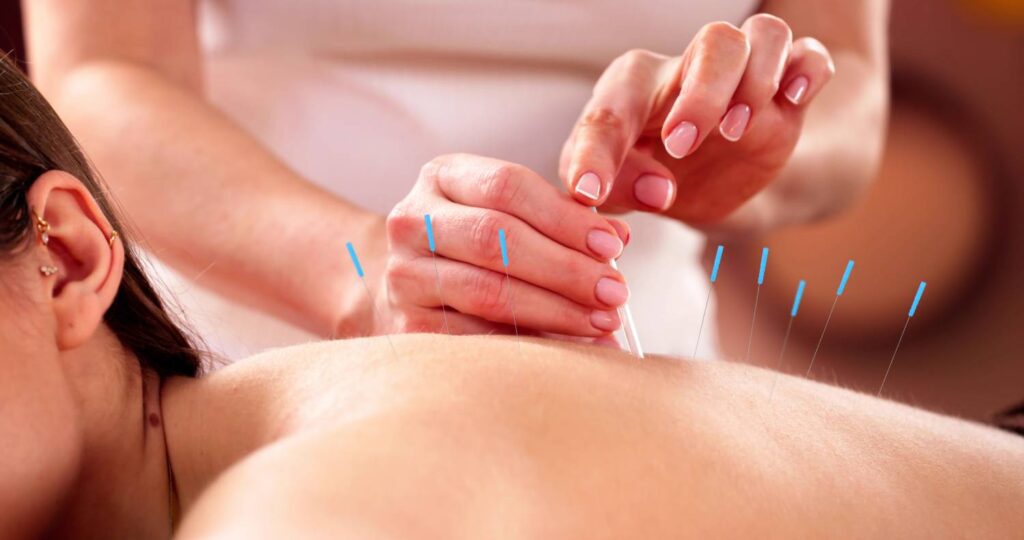We have some pretty great news to share! As of July 2024, physical therapists who complete the required training, are allowed to perform dry needling in WA State.
Physical therapists worked for many years to get dry needling added to our practice act in WA. Prior to this legislative success, WA was one of only 5 states where PT were not allowed to DN.
This is a huge win for patients and physical therapists! Lucky for us (and our clients), Paige Vivian, PT, who joined our team in December, received her dry needling endorsement last year. She’s now offering this service at our Madison Park clinic.
Wondering what dry needling is? Most people are new to it, so here’s what you want to know …
It’s a simple technique that can result in big gains (more details below). I think of that relentless, walnut-size knot in someone’s upper traps that it takes me MANY sessions to relieve with traditional soft tissue techniques and movement re-education.
Dry needling can actually release that knot or trigger point more efficiently.
Dry needling is great for:
- Relieving headaches, including migraines and tension headaches
- Muscle pain and tightness; especially the kind that temporarily feels better with massage or soft tissue techniques
- Calming your nervous system so your musculoskeletal system to respond better to physical therapy and exercise in general
- Pain resulting from herniated discs in neck or low back
- Persistent buttocks tightness from sciatic-like symptoms
- Anyone who likes how they feel after a massage, but has to keep getting massages to feel good, because the pain comes back.
Dry needling paired with the right exercises to retrain the previously tight/dysfunctional muscles is like magic. We’re talking long term relief.
I think a good ‘ol FAQ about dry needling is in order here so that you know if dry needling might be a good addition to your plan of care.
FAQs:
Dry needling is a highly effective form of physical therapy for the treatment of a multitude of musculoskeletal and neuromuscular conditions.
It’s not appropriate for all conditions or pathologies and the use of the technique will be at the discretion of your physical therapist.
Dry needling is not acupuncture (traditional Chinese medicine).
It’s based on neuro-anatomy and modern scientific study of the musculoskeletal and neuromuscular systems.
A very fine filament needle is inserted through the skin and into the deeper tissues that are considered trigger points to your pain.
Dry needling works by causing a micro lesion within the pathological tissue thus breaking up shortened tissues, inhibiting a reflex arc from the nervous system to the tissue, normalizing the inflammatory response, and centrally mediating the pain.
This mechanical and neuromuscular effect provides an environment that enhances the body’s ability to heal which ultimately reduces pain.
Conditions include, but are not limited to neck, back and shoulder pain, arm pain (tennis elbow, carpal tunnel, golfer’s elbow), headache to include migraines and tension-type headaches, jaw pain, buttock pain and leg pain (sciatica, hamstrings strains, calf tightness/spasms).
The fine filament needle is very thin, solid, and flexible, which allows for the needle to be pushed through the skin versus cutting the skin. This helps reduce any discomfort that may occur with the procedure.
We strive to make the treatment virtually painless however at times a local twitch response of the muscle may be felt.
When the needle is inserted into the pathological tissue the local twitch response sensation is normal and is felt only momentarily. Many patients describe this twitch response as a little electric shock, cramp or an ache sensation.
These sensations are perfectly normal and even a desirable response. Your PT will make every effort to make your experience comfortable and therapeutic.
Yes! What’s great about adding DN into your PT plan of care is the pace of your progress may increase or it may help you get past a plateau in the gains you’re making.
Do you think you have some trigger points that could benefit from dry needling?
Want to know if dry needling could get you past a plateau or help you make faster gains?
If you’re currently seeing someone on our team, ask them if you could benefit from a couple visits with Paige.
If you want to grab Paige’s next opening, call/text 206-535-7356 or email schedule@elizabethrogrspt.com to schedule time with Paige to explore whether dry needling may help you!
Not all medical or physical therapy professionals are trained to perform the dry needling. In order to perform dry needling in WA State, physical therapists must have a special endorsement. To receive this endorsement, they must meet the state requirements for advanced training and practice hours.
Yes, we only use sterile disposable needles.
Maybe. This will vary but many patients experience immediate relief of their symptoms and an increase in range of motion.
Soreness can also be a common response from the needling but does not occur with all people. Some individuals may experience an immediate achiness or a delayed soreness the next day.
The soreness, if present, will usually last 1-2 days. Use of heat and light massage and movement will be beneficial.
Mild bruising may occur at the needling sites and is more prevalent in certain parts of the body. Larger bruising may also occur, but is rare.
Application of ice on the bruise will help with the soreness and the skin discoloration will last several days but is not harmful.
DN likely isn’t the right treatment choice for you.
Our team has a wide variety of tools in our tool kits. We don’t use all these tools with every patient. We make our treatment plans based on the needs, problems, goals and preferences of each patient.






